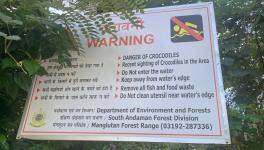New Forest Law Overlooks Deforestation Link With Covid-19 Calamity

Prerna Singh Bindra, a wildlife conservationist and author of The Vanishing: India’s Wildlife Crisis, was a member of the Standing Committee of the National Board for Wildlife. She was among a group of retired forest officers who petitioned the Supreme Court to review the Forest Conservation (Amendment) Act, which came into force on December 1. The government assured the Supreme Court on November 30 that no “precipitative action” would be taken until further orders, with regard to forests as envisaged in the 1996 Godavarman judgement of the Supreme Court. The SC, accordingly, did not stay the operation of the amended Act. But environmentalists are not convinced that states will await guidelines before giving up large tracts of natural forest to ‘development goals’. Speaking to journalist Rashme Sehgal, Bindra explains why this is a serious matter.
Rashme Sehgal: There is a view that the Forest Conservation (Amendment) Act (FCAA), which came into force on December 1, would facilitate the diversion of forest land into private hands on a large scale. Why is this a concern among environment-watchers, and why and to what extent could such diversions occur?
Prerna Bindra: Despite several estimates being bandied around, the truth is, we do not know just how much land will be diverted. What we know is that the scale would be enormous and horrific. Each and every patch of forest is vulnerable to diversion and destruction mainly due to the following factors:
First, the FCAA practically nullifies the Supreme Court’s 1996 Godavarman judgment, which would remove legal protection from millions of hectares of land that have the characteristics of forests but are not notified as such.
Second, it exempts many activities and is deliberately ambiguous with loosely-defined or even non-defined terms. For example, Section 1(A)2 exempts up to five hectares in Left-wing extremism (LWE) areas for defence-related and public utility projects, but there is no clarity on what is ‘public utility’, which could be anything from toilets to a convention centre or a mall.
This clause risks one of the finest tiger and elephant forests in Central and East-Central India. It also allows up to 10 hectares to be used to construct security-related infrastructure, though whether this is national, financial or food security is not explained.
For laws to be applicable, they need to be clear and unambiguous, not unwieldy and confusing.
RS:Do you believe that the ambiguity is deliberate?
PB: Yes. The original Forest Conservation Act (FCA), 1980, was short, crisp, clear and, importantly, had a clear objective to stop deforestation, though it undoubtedly required better implementation. The Van (Sanrakshan Evam Samvardhan) Adhiniyam (as the FCAA is called in Hindi) apparently has the objective of achieving Net Zero targets, but nothing in the Act reflects the title, “sanrakshan—protection”, or “samvardhan—regeneration”.
There is a disconnect between the preamble and the substance of the Act: The FCAA enables forest destruction; how does one decarbonise when deforestation is a key cause—by some estimates, of 12-20% of greenhouse gas (GHG) emissions. Natural, old-growth forests are more effective—as per a study, 40% more so—than plantations [in controlling GHGs]. Besides, it is hubris to think humans can grow forests, which take millennia to evolve into complex ecosystems.
RS: You mentioned the Godavarman judgement, but hasn’t the government assured that the Act does not undermine it. Can you explain?
PB: The 1996 Supreme Court order strengthened the original FCA to encompass “forest” as understood by its dictionary meaning and regardless of ownership, recognition or classification. It mandated setting up State Expert Committees to identify such forests based on sound parameters. The Ministry of Environment Forests and Climate Change (MoEFCC) assured that it would protect all forests as identified by the State Empowered Committees (SEC), which included deemed forests. But where are these expert committee reports, and what do they contain? Have all states prepared them, and are they scientifically robust?
I have seen the Kerala SEC, but it turned out to be a hastily prepared document with no qualitative data and is not based on field exercises. The situation is probably the same for most states. None of the SEC reports is in the public domain, and so we, the people, are in this horrific situation where we don’t know where our forests are, while the state governments are quietly diverting them most undemocratically.
Also, this ambiguity is conveniently misinterpreted. Odisha had promptly given an order even before the law came into force—subsequently withheld—saying that deemed forests are removed from the amended FCAA. There are reports that Odisha has 66 lakh hectares of deemed forests, which can be subject to destruction. This provides an indication of the potential scale of destruction. We don’t know the situation in other states and fear they will all fall over themselves to usher in the amended Act.
RS: What about the MoEFCC’s claims in the Supreme Court?
PB: I am among a group of petitioners who have challenged the constitutionality of the FCAA. At the hearing on November 30, the MoEFCC assured the Supreme Court that the State has no intention to dilute the scope of “forest” as defined in the Godavarman judgment. It said that no precipitative actions will be taken in respect of “forest”—as understood in the dictionary sense of the term—until further orders. The government has given an assurance, but the law says something else.
RS: The government claims forests will be uprooted to free land for development— mining, infrastructure, roads, malls. But surely there must be some idea of how much land should be set aside for forests to ensure that ecosystems remain intact? Across the Indo Gangetic Plain there is an enormous problem of air pollution. If forests are destroyed, we will be left with no protection from pollutants.
PB: You are right. There have to be some forests and ecosystems which are ‘no-go’. We are far from achieving the national target of 33% forests. If that be our mandate, all forests are a no-go, and we should be working towards protecting and restoring degraded forests. We cannot endlessly destroy nature, which is a finite source. Some places have to be sacrosanct, and there is nothing more sacrosanct than a forest.
India is an environmental basket case. We are choking Delhi; our lungs are working to a third of capacity, and our lives are being cut short by pollution. Our rivers are dustbins, our soils poisoned and toxic. We are a climate-vulnerable, water-scarce country. We have ravaged our ecosystems—blasting mountains, damming rivers, paving our wetlands—and we are losing biodiversity, with species going locally extinct-like the Great Indian Bustard and the Lesser Florican to cite two examples.
Conservation is not just about saving tigers and birds. We need healthy ecosystems and a safe environment. Our GDP relies heavily on rain—one bad monsoon can plummet the economy. Forests are rainmakers. The monsoon depends on forests.
Our health, livelihood, economy, growth—everything depends on nature. And biodiversity is critical to the health of ecosystems; every creature has an ecological niche, with wildlife being the bedrock of our ecological security. Yet, the government views the environment as being a hurdle to development, and this attitude has permeated to the public at large.
RS: Is the public unaware of the potentially fatal consequences of using development as a bogey while damaging the environment? Also, what led the government to introduce this amendment in the first place?
PB: I cannot speak for the government, which has been steadily diluting all our environmental laws on an unprecedented scale. Earlier, there was at least some fig leaf offered in the name of protecting the environment; there were some face-savers of going so far and no further. Now, the ministry mandated as the guardian of forest crows about easing the [industrial] clearance process and the high number of approvals granted for destructive projects—mines and other infrastructure in our forests and protected areas.
About 98% of proposals for diverting forests are cleared—so where is the balance between environment and development? And these are being cleared on the basis of shoddy Environment Impact Assessments. There are no site visits or robust studies. Projects are being approved in virtual meetings. Institutions and bodies such as the National Board of Wildlife and Forest Advisory Committee have been weakened and appear to be nothing more than rubber stamps.
I also see this as an issue of our democracy. Why don’t people know where our forests are? How is this democratic? How can peoples’ voices, especially those in remote corners of the country, be heard when a law of such importance is being amended? They were given just about two weeks to respond to it.
In the broader sense, all of us depend on forests, but millions in our country are directly dependent on forests—adivasis, farmers and others especially in rural India. It is not just livelihood, forests provide food security for the marginalised during lean periods. No culture is so embedded in nature as ours, yet we seem to have forgotten the links between health, livelihood and forests.
RS: Desertification is an irreversible process, but we see it unfold, as in the Aravalli Hills. What would happen to it under the FCAA as it stands now?
PB: The Aravalli hills are the oldest mountain range in the world, which itself we must respect. It’s a unique ecosystem of scrub forests, arid land and dry deciduous forest—and supports leopards, hyenas, porcupines, jackals and other wildlife. The Aravalli stands between Delhi and the Thar desert, preventing its rapid desertification. They are a watershed zone vital for the existence of the population of the NCR (National Capital Region). Most of the Aravallis are not recorded as forests but fall in the category of gair mumkin pahar [hills impossible to cultivate]. They will lose legal protection under the amended FCA.
RS: What could be the effects of such losses?
PB: The implications of large-scale forest destruction will be calamitous. A poor environment endangers our health; we just lived through the trauma of COVID-19, which caused so much human tragedy and brought the economy to its knees. And yet we have not learnt. Zoonotic diseases are increasing exponentially and will continue to do so unless steps are taken to protect wildlife and preserve the environment
There are other ramifications—the scale of forest destruction and fragmentation will see a sharp escalation of human-wildlife conflict, which is already severe. More than 500 people are killed annually by elephants, who are running out of space and food. With the forests destroyed, where is our wildlife to go?
India has been a leader in conservation, saving endangered megafauna despite our population, the poverty of our people and our development imperatives. But we have lost the vision, the way and the political will.
(Rashme Sehgal is an independent journalist.)
Get the latest reports & analysis with people's perspective on Protests, movements & deep analytical videos, discussions of the current affairs in your Telegram app. Subscribe to NewsClick's Telegram channel & get Real-Time updates on stories, as they get published on our website.
























